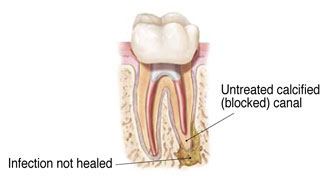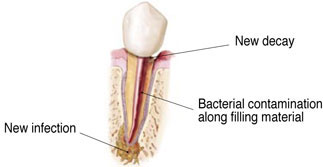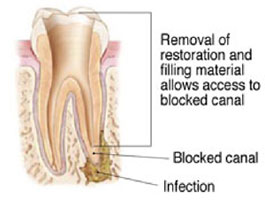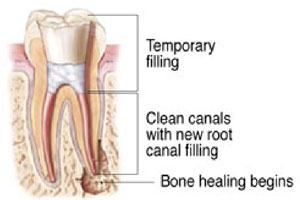





Endodontic Retreatment
With the appropriate care, your teeth that have had endodontic treatment will last as long as other natural teeth. Yet, a tooth that has received root canal treatment may fail to heal or pain may continue to exist. Sometimes, the pain may occur months or years after treatment. If so, endodontic retreatment may be needed.
Improper healing may be caused by:

- Curved or narrow canals that were not treated during the initial root canal.
- Extra canals that went undetected during the initial treatment.
- The crown or permanent filling was not placed within the appropriate amount of time following the initial root canal.
- The crown or permanent filling did not prevent saliva from contaminating the inside of the tooth.

In some cases, new problems can influence a tooth that had a successful root canal:
- A new cavity can expose a root canal filling material to bacteria, causing infection.
- A cracked or loose restoration can expose the tooth to new infection.
Retreatment involves reopening your tooth, removing the old root canal filling material and addressing any other issues that led to reinfection of the original root canal. Once this is accomplished, the canals will be refilled and a temporary filling will be placed in the access as was done during the original root canal treatment.


At this point, you will need to return to your dentist as soon as possible in order to have a new crown or permanent filling placed in the tooth to complete the seal and restore full functionality.
Home | Patient Information | Instructions | Dental Anxiety & Sedation | Procedures | Meet Us| Online Forms | Referring Doctors| Contact Us |Disclaimer | Site Map
Mark R. Jensen, D.D.S. • Susan G. Penniston, D.D.S., M.S. • Bradford J. Pugh, D.D.S. • Matthew G. Del Mastro, D.M.D. • Philip J. Wadsworth, D.M.D.
3401 Hwy 169 N, Plymouth MN 55441 • Phone: 763-559-0859 Fax: 763-559-4356
12000 Elm Creek Blvd., Suite 240, Maple Grove, MN 55369 • Phone: 763-416-3619 Fax: 763-416-3695
3905 Silver Lake Road, St. Anthony, MN 55421 • Phone: 612-248-8330 Fax: 612-315-5378
Endodontic Website Designby PBHS 2012©
